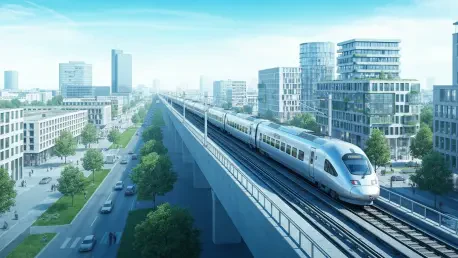In the heart of Southern Germany, a monumental railway project has captured both attention and controversy for over a decade, promising to revolutionize transportation but stumbling under the weight of its own ambition. This transformative initiative, aimed at converting Stuttgart’s central rail hub into an underground through-station, was envisioned as a cornerstone for enhanced connectivity across Europe, linking major cities like Paris and Budapest. Yet, persistent delays and spiraling costs have turned this dream into a cautionary tale of infrastructure challenges. With expenses ballooning from an initial estimate of €4.5 billion to over €11 billion and completion now pushed beyond 2027, the project underscores the intricate balance between vision and execution. The mounting setbacks have not only frustrated stakeholders but also raised critical questions about the management of large-scale public works in Germany, setting the stage for a deeper exploration of what went wrong and what it means for the future of regional development.
Challenges Facing the Ambitious Rail Overhaul
Technical Hurdles Stalling Progress
The path to modernizing Stuttgart’s rail infrastructure has been fraught with unforeseen technical obstacles that have significantly delayed timelines. One of the most pressing issues lies in the geological complexities encountered during underground construction, where unexpected subsurface conditions have repeatedly halted tunneling efforts. These challenges have demanded costly redesigns and additional resources, pushing the project far beyond its original scope. Beyond the physical barriers, engineering teams have struggled with integrating advanced rail systems into an already constrained urban environment, further complicating the work. The cumulative effect of these technical difficulties has been a frustrating cycle of stoppages and reevaluations, eroding confidence in the project’s feasibility. As a result, the anticipated benefits of improved rail efficiency remain out of reach for the region, leaving commuters and businesses grappling with outdated infrastructure for years longer than expected.
Moreover, the technical setbacks have exposed broader systemic issues in planning such ambitious endeavors. Insufficient initial surveys and risk assessments failed to account for the unique challenges of constructing beneath a bustling city, leading to repeated missteps. Each delay has compounded the frustration among stakeholders who were promised a state-of-the-art transit hub. The situation highlights a critical need for more rigorous pre-construction analysis and adaptive engineering solutions to navigate the unpredictable nature of large-scale underground projects. Without addressing these foundational flaws, similar initiatives across Germany risk falling into the same trap of endless revisions and stalled progress. The ongoing struggle serves as a stark reminder that even the most visionary infrastructure plans can falter when faced with the harsh realities of technical execution, emphasizing the importance of preparedness over optimism.
Financial Overruns Straining Resources
Equally daunting are the financial burdens that have ballooned alongside the project’s delays, placing immense pressure on both public and corporate budgets. Costs that were once pegged at a manageable €4.5 billion have skyrocketed to over €11 billion, a figure that continues to climb with each passing year of delay. This staggering overrun stems from a combination of underestimated initial budgets and the unforeseen expenses tied to technical challenges. The financial strain has not only impacted the project itself but also raised concerns about the diversion of funds from other critical rail improvements across the country. Deutsche Bahn, the primary overseer, now faces scrutiny over its fiscal management, as taxpayers and investors question how such a vital initiative could spiral so far out of control.
Additionally, the economic ripple effects of these overruns extend beyond mere numbers, influencing broader infrastructure strategies in Germany. The escalating costs have forced difficult decisions about resource allocation, potentially delaying or canceling other regional projects that could benefit local economies. This financial mismanagement has also sparked debates about accountability and transparency within large public works, as stakeholders demand clearer justifications for the mounting expenses. The situation underscores a pressing need for more robust budgeting frameworks and risk mitigation plans to prevent similar fiscal disasters in future endeavors. Until these issues are addressed, the project risks becoming a symbol of inefficiency, casting a shadow over Germany’s reputation for precision and reliability in infrastructure development.
Broader Implications for Infrastructure and Regional Growth
Impact on Deutsche Bahn’s Reputation
The cascading delays and financial missteps have taken a significant toll on Deutsche Bahn, the state-owned railway company tasked with steering this massive undertaking. Public and investor confidence in the organization has waned as each missed deadline and budget revision paints a picture of mismanagement and lack of foresight. This erosion of trust threatens to impact not only current operations but also future funding and partnerships, as stakeholders grow wary of committing to projects under Deutsche Bahn’s leadership. The company’s struggle to deliver on its promises has become a focal point of criticism, with many questioning whether internal reforms are needed to restore credibility in handling such transformative initiatives.
Furthermore, the reputational damage extends to operational efficiency, as the delayed rail hub continues to hinder seamless transportation across Southern Germany. The inability to provide the promised connectivity affects daily commuters and freight services alike, stalling economic momentum in a region poised for growth. This ongoing failure to deliver has broader implications for how major infrastructure projects are perceived, potentially discouraging investment in similar upgrades elsewhere. Addressing these concerns will require Deutsche Bahn to prioritize transparency and demonstrate tangible progress, proving that lessons have been learned from the ongoing challenges. Without such efforts, the company risks long-term consequences that could undermine its standing as a leader in European rail services.
Economic and Regional Setbacks
The prolonged timeline for completing the rail overhaul has had a direct impact on the economic vitality of Stuttgart and surrounding areas, where improved transportation was expected to drive growth. Businesses that anticipated better access to markets through enhanced rail links have been left waiting, losing out on opportunities for expansion and efficiency. Similarly, commuters face continued reliance on outdated systems, hampering productivity and quality of life in a region that serves as an economic engine for Germany. The delay in realizing these benefits has created a palpable sense of frustration among local leaders and residents who see the project as a missed chance for regional advancement.
Beyond immediate economic losses, the situation has sparked broader concerns about the viability of large infrastructure projects as catalysts for development. The setbacks have highlighted how delays can disrupt long-term planning, leaving municipalities and businesses in limbo as they await critical upgrades. This scenario emphasizes the interconnectedness of infrastructure and economic progress, showing how one faltering project can have widespread repercussions. Moving forward, there must be a concerted effort to mitigate such risks through better coordination and contingency planning, ensuring that future initiatives deliver on their promises without derailing regional aspirations. The experience serves as a critical lesson in balancing ambition with practicality to avoid similar disappointments.
Lessons for Future Infrastructure Endeavors
Reflecting on the challenges faced, it becomes evident that the project’s struggles offer valuable insights into managing large-scale public works. In the past, inadequate planning and underestimation of risks led to a cascade of technical and financial issues that could have been mitigated with more thorough preparation. The experience underscores the necessity of comprehensive feasibility studies and realistic budgeting to prevent unforeseen setbacks from derailing progress. By addressing these gaps early, planners could have avoided the costly cycle of delays and revisions that defined much of the project’s history.
Moreover, the ordeal highlights the importance of transparency and stakeholder engagement in maintaining trust throughout such initiatives. Past failures to communicate effectively with the public and investors fueled skepticism and criticism, amplifying the negative perception of the project. Adaptive strategies and contingency plans also emerged as critical tools that were underutilized, as rigid approaches struggled to accommodate unexpected challenges. Looking back, a stronger emphasis on flexibility and open dialogue could have softened the impact of setbacks, providing a roadmap for how to navigate the complexities of infrastructure development in the future.









